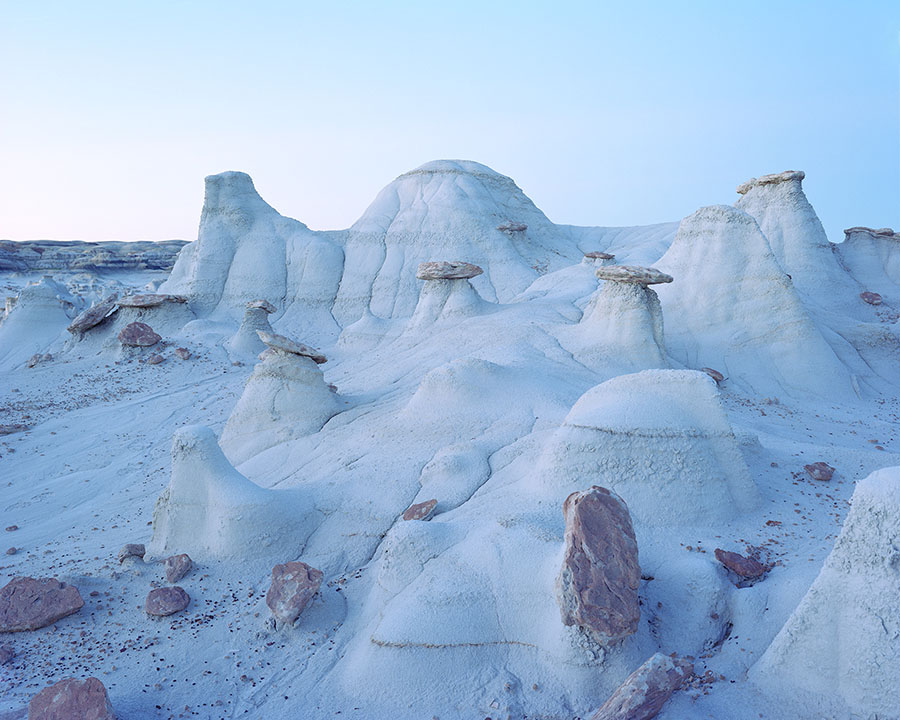Few places on Earth are as surreal and alien as the desert. The near complete lack of organic life is something entirely foreign to most people, as is the sense of desolation inherent to the desert landscape. The word deserted is, of course, phonetically tied with the desert, further evoking a sense of loneliness and alienation.
But there is also great beauty in the desert – powerful, all-encompassing and absolute. And Italian photographer Luca Tombolini is a master at capturing the surreal, prehistoric glory of these landscapes.

Italian photographer Luca Tombolini is a master at capturing the surreal, prehistoric beauty of desert landscapes. Get lost in the wild below.
Tombolini’s latest series, simply titled LS X, is his latest photographic expedition to the desert. His previous pilgrimages have taken him all over the world, from Iceland to Morocco, where he has documented the charms and idiosyncrasies of each environment.
LS X saw him exploring the deserts of the Amercian West, a region characterised by its dazzling white sands, pale mountains, and dreamy skies. Speaking about his fascination with the desert, Tombolini reflects that it’s rooted in a somewhat childlike fascination and a sense of wanderlust he got from flicking through his parent’s travel and photography books.
“When I was a kid, in my parent’s house there was these couple of photobooks of photographers and travellers, Fratelli Castiglioni, which documented their expeditions crossing the Sahara on 4x4s. I remember on lazy evenings going back often to those images.
That is the first moment I can recall about the right jigsaw falling into place. Later on, after the youth storms, I began to appreciate the rhythm of travelling alone and logically all the fascination I felt for the desert united myself to it.”
LS X is perhaps the most abstract of Tombolini’s collections, but also the most unified, tied together by pastel hues and soft tones. His photographs are large format, shot on negative film that is drum scanned, a process that gives the photographs greater resolution, detail, sharpness, and dynamic range.
A commercial photographer by day, the LS series is a passion project for Tombolini, one that documents his travels slotted in between commercial projects. He scouts his location remotely, scouring the web for where to visit next.
“Usually, when people go out with friends to have a beer, I stay home with Google Earth. Which doesn’t tell me much about what I’m looking for but at least it’s a start.”
In this sense, he traverses the line between travel and landscape photographer, yet he doesn’t quite define himself by any one style or process.
“I wouldn’t even fit in 90% of the definitions of “photographer”,” he says. “Moreover I work with landscapes, true, but I don’t have an interest of describing any place. I’m a traveller but I don’t do “travel photography”… I do something which is a mix of travelling, photographing and self-individuation.”
Aside from being concerned with place, and the forms and shapes of the desert, Tombolini’s work also explores the significance – or insignificance – of time. The landscapes he shoots are simultaneously aged and ageless, and his process is not bound by temporality.
“We humans have a bugged perception of Time,” he says. “It works well for our daily tasks but any physicist will tell you that we’d better think of Time and Space as a single entity, TimeSpace. The implications of this concept are quite heavy, as for instance we don’t move through Time as we would say we do, but we are a defined segment of it for an observer with a different frame of reference than ours.
This, and many other speculations and paradoxical thinking about Time, are taken into account when I photograph. Photographing became a way to confront myself with questions I’d never ask myself in a daily routine, scientifically and spiritually at the same time. It’s true I’ve got no answers to all that but nevertheless I’m feeling there would be something missing if I wasn’t there to observe it.”

















Hit the link below to see more of Tombolini’s work.



